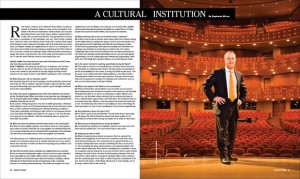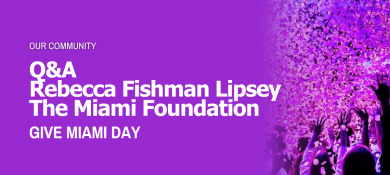Ricky Arriola, chairman of the Adrienne Arsht Center, was just appointed by President Obama to serve on the 26-member Committee on the Arts and Humanities, which includes a mix of actors like Edward Norton and Sarah Jessica Parker, musicians like Yo-Yo Ma, and icons like Anna Wintour.
The appointment is for those who have a commitment to the humanities and arts, which Arriola certainly does. Under his watch, the Adrienne Arsht Center—the country’s third largest performing arts center—balanced its budget, paid off its bank debt seven years early, and helped revitalize the neighborhood in which it is a centerpiece. Arriola, who is just as likely to be seen enjoying a symphony at the Arsht Center as he is to be seen rocking out backstage during a Marley Brothers performance, spoke with Haute Living about the role of the center and the impact of Art Basel.
 Haute Living How long have you been with the Adrienne Arsht Center, and how did you become involved?
Haute Living How long have you been with the Adrienne Arsht Center, and how did you become involved?
Ricky Arriola I am going into my third year as chairman, and I’ve been with the center for six years. At that time, it was a newly formed institution in town and I wanted to get involved in the early stages and help provide direction for the center so that it could fulfill the aspirations of the community.
HL What does your role as chairman entail?
RA I basically chair all of our board meetings, provide leadership at the board level, help our CEO in whatever capacity he needs, make sure that the center has good stewardship, good governance policies, good oversight—traditional board chair responsibilities.
HL There were some budgeting issues when the institution was known as the Carnival Center. When you came on as chairman, you managed to turn it around, balance the budget, and pay off the loan way ahead of the deadline. How did you do so?
RA A number of things happened. One, the incredible generosity of Adrienne Arsht helped to solve a lot of the financial issues that we had at the time. Since then, we have continued fundraising and continued growing our audience. Ticket sales, fundraising, and keeping a tight control on our expenses has led us to have balanced budgets and surpluses two years in a row. And this year is not going to be any different. I think the foreseeable future is going to be financially very positive.
HL What role does the Adrienne Arsht Center serve in the community?
RA I think we serve multiple purposes; one is that we serve as a town square, a place where our whole community can come together and celebrate things that are occurring. Earlier this year we broadcasted the inauguration of the president; now that we’re in the holiday season, we’ll come together and celebrate.
The other purpose is to celebrate great art, to bring art from around the world and give our community exposure to it. Another important part of our mission here is arts education—to make sure that we’re exposing young children in our community to the arts.
HL How did the Arsht Center revitalize the neighborhood as a whole?
RA As an economic development engine, we have, from the county’s estimates, been responsible for over a billion dollars worth of construction just in this area. That does not include the impact that we’re having on creating a cultural, international city that attracts tourists and businesses to the community because of our thriving cultural landscape. The center has brought a lot to the neighborhood—a lot of building, a lot of cleanup, a lot of street traffic, nightlife, and increased international exposure that Miami is a cultural Mecca. It brings people from around the world to Miami, and not just for the beaches.
HL What would you like to see on the Arsht Center’s calendar?
RA I’d like to see us have an acoustic music series, which we’re actively working on—the Indigo Girls are coming in the spring. I’d love to see more hip-hop, and other genres you don’t traditionally associate with performing arts centers. We have done programming of that nature successfully, and I think that we’re creating a new prototype for performing arts centers in the 21st century. Traditionally, they’ve been about the classical music and dance performances, and I think we’re starting to break with tradition and do a lot more international programming, a lot more cutting edge and contemporary programming. I think that’s one of the things that is going to define us as a performing arts center.
HL Is the center involved in anything specifically during Art Basel?
RA The center is a work of art—everything from our floors, which were done by Jose Bedia, to sculptures and mosaics. We have dozens of prominent art pieces and installations in the center, so during Art Basel we give tours. Over the years, we’ve collaborated with multiple galleries, so Art Basel and the Performing Arts Center have been good partners. This year, we have some folks who are going to be coming in for meetings and conferences, and we have our own shows going on during Art Basel.
HL What is the impact of Art Basel on the community?
RA When Art Basel first came to Miami, it was an instant success and it’s been building every year. Art Basel is focused on the visual arts, and it brought international acclaim to our city for our embracing of culture. Miami is now viewed as a city that takes culture seriously, that we embrace the finest art forms, celebrate them, support them, and I think that’s why Art Basel’s been so successful down here. Miami is a city that people from around the world want to visit. The Performing Arts Center is now building on some of the things Art Basel was able to do, and it’s also benefiting all of our local arts organizations.
HL Any predictions about this year’s fair?
RA I’m told it’s going to be well attended. The important thing is that quality art will always sell, and Art Basel has always been about quality. So my expectations are that it will be strong, but maybe not as frothy as other years.
HL What are you looking forward to during Art Basel?
RA I’ve blocked my calendar off completely; I intend to see every inch of Art Basel and the satellite fairs. You need several days to take it all in.
HL Anything you want to add?
RA Miami is experiencing a cultural renaissance that has captured the attention and imagination of art lovers from around the world, both of the visual and performing arts. Our community has recognized that this is an economic development issue, and also something that they can be proud of. We are leading the nation and becoming a very important player in the world’s cultural landscape. And I think it’s something the community is proud of, recognizes, and has embraced. If you look at the fact that so many of these buildings—the Arsht Center, the New World Symphony, Museum Park—that were built or will be built are coming from taxpayer dollars, that is evidence that the community gets it and wants to make a long-term commitment to the arts. And for that reason, I think Miami will become, if it isn’t already, one of the major cultural cities of the world.







 See More Blogs
See More Blogs
Comments